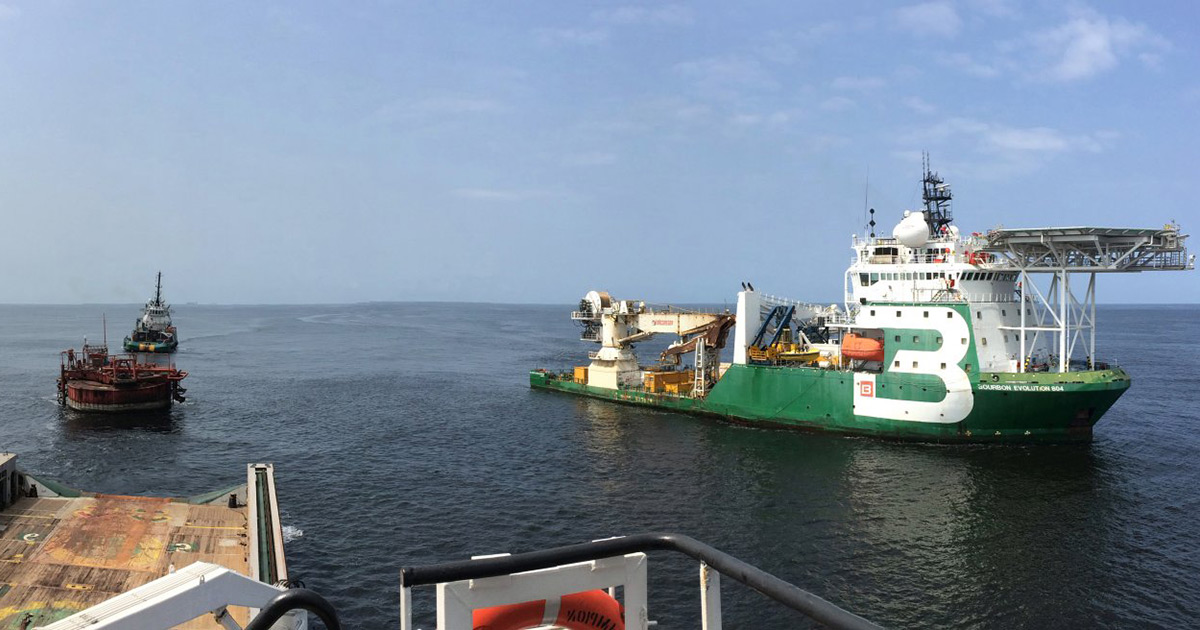Subsea operations are special in that they frequently require customized solutions to meet very specific needs.
The engineering teams must make the difference and their experience is vital, as we have seen in the past with the well clean-up carried out for the first time from a vessel (read PartnerShip #4). The operation to decommission a CALM1 (Catenary Anchor Leg Mooring) buoy in the Kuito oilfield in Angola, was also a first for Bourbon Subsea Services, which provided the engineering for the project.
1CALM: floating buoy anchored on the seabed by catenary chains fixed to anchors
Between July 27 and August 12, 2018, the crews of Bourbon Subsea Services, in association with a number of operators, carried out the disconnection of the CALM buoy and then towed it to the Sonamet Yard in Lobito (Angola) for decommissioning. In production from 2000 to 2014, the Kuito oilfield was no longer operated: the FPSO had been disconnected in 2014 and one of the six moorings of the buoy had ruptured. The challenge: to ensure the coordination and supervision of disconnection operations.
“Bourbon Evolution 804 was positioned to raise the anchor chains: thanks to its ROV and crane, the vessel was perfectly suited for the operation”, says Philippe Mazurier, Bourbon Subsea Services project manager. After being cut at a depth of nearly 400 m by the ROV, the chains were lifted and cut up aboard a tug chartered by the client. The risers had been previously cut by a diving team contracted by the client. During this decommissioning operation, AHTS Bourbon Rhesos was connected to the buoy to check its movements and limit the tension on the remaining anchors. Equipped with navigation lights for the occasion, the buoy was then towed for 4 days to Lobito.
“We had to face several difficulties: it was an old installation and access to the buoy had deteriorated. Several vessels worked at close quarters around the buoy and there were numerous operators”, he added. Consequently, the teams participated in numerous briefings to better prepare the operations. To board the buoy, whose ladder had been damaged and no longer met classic boat landing criteria, the seamen were equipped with harnesses and access was strictly limited by weather criteria and conditions of luminosity. Perfect coordination between the crews was necessary to manage the proximity of the vessels at work: regular contacts, painstaking preparation, anticipation of the movements of the vessels, the effect of waves and the movements of the buoy, dedicated radio channels, strict procedures... “Our crew on site left no room for improvisation”, affirmed Philippe Mazurier.
The operation was postponed several times because the client wanted to be able to simultaneously position the three vessels with which they already had long-term contracts. ”The BOURBON crews had to be particularly flexible and make themselves available as soon as the client had its operational window”, said Philippe Mazurier. It was the first engineering and supervision contract for this client and the crews of the Bourbon Subsea Services grasped the opportunity to demonstrate their expertise. The deadlines were respected with the crews working round the clock. “We are particularly satisfied with the cooperation between the many different operators: this enabled the project to be carried out successfully and efficiently with no accidents”, he concluded.
1CALM: floating buoy anchored on the seabed by catenary chains fixed to anchors


